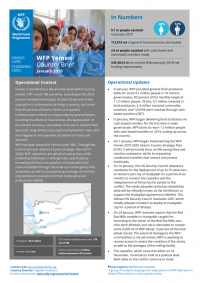WFP Yemen Country Brief, January 2019
Operational Context
Yemen is classified as a low-income, food-deficit country, ranked 178th out of 189 countries, according to the 2018 Human Development Report. At least 50 percent of the population is estimated to be living in poverty, and more than 90 percent of food in Yemen is imported.
Limited access to food is compounded by several factors, including the effects of low incomes, the depreciation of the Yemeni currency, uncertainty of access to Yemen’s Red Sea ports, large family sizes, high unemployment rates, and the irregular or non-payment of salaries of many civil servants.
WFP has been present in Yemen since 1967. Through the current two-year Interim Country Strategic Plan (2019-2020), WFP operations are aimed at saving lives, while protecting livelihoods in emergencies, specifically by increasing the food consumption of vulnerable food insecure people through the scale-up of emergency food assistance, as well as by expanding coverage of nutrition interventions to prevent and treat moderate acute malnutrition (MAM).
Operational Updates
• In January, WFP provided general food assistance (GFA) for some 9.1 million people in 19 Yemeni governorates, 80 percent of the monthly target of 11.3 million people. Of this, 6.7 million received in-kind assistance, 2.4 million received commodity vouchers, and 123,694 were reached through cash-based transfers (CBT).
• In January, WFP began delivering food assistance via cash-based transfers for the first time in Aden governorate. WFP plans to reach 1.5 million people with cash-based transfers in 2019, scaling up across the country.
• On 1 January, WFP began implementing the WFP Yemen 2019-2020 Interim Country Strategic Plan (ICSP). It will primarily focus on life-saving food and nutrition assistance, whilst incorporating conditional transfers that restore and protect livelihoods.
• On 16 January, the UN Security Council adopted a resolution for the deployment of up to 75 observers to Yemen’s port city of Hudaydah for a period of six months to monitor the ceasefire and the redeployment of forces by the parties to the conflict. The newly-adopted resolution establishes what will be officially known as the UN Mission to support the Hudaydah Agreement (UNMHA). This follows UN Security Council resolution 2451 which initially allowed monitors to deploy to Hudaydah city for a period of 30 days.
• On 24 January, WFP received reports that the Red Sea Mills complex in Hudaydah caught fire. According to the owner of the Red Sea Mills, two silos were affected, one silo is estimated to contain some 4,500 mt of WFP wheat, 9 percent of the total wheat stored. The extent of damage to the WFP commodities is not yet known, WFP is awaiting to receive access to assess the condition of the stocks, as well as the damages of the milling facility.
• The ceasefire, which came into effect on 18 December, continues to hold at a political level. Both sides to the conflict continue to trade accusations of breaches. On 17 January, Dutch Major General Patrick Cammaert and the team of Redeployment Coordination Committee were reported safe after an armoured car in their convoy was hit by a bullet following a meeting with the Internationally Recognized Government of Yemen (IRG).
• The International Committee of the Red Cross (ICRC) has stated that is undertaking preparations to facilitate the release and transfer of prisoners under the prisoner exchange agreement that emanated from the Sweden peace talks. The ICRC has increased its personnel presence in Yemen, is working to rehabilitate transfer locations and is preparing to provide medical assistance. Two planes are also being prepared to shuttle detainees between Sana’a and Sayoun.
https://reliefweb.int/report/yemen/wfp-yemen-country-brief-january-2019


